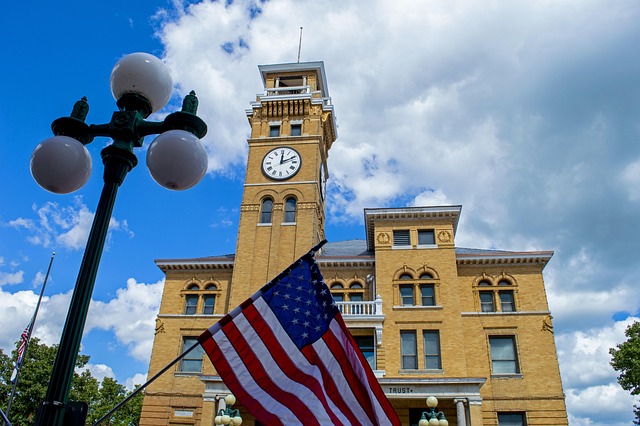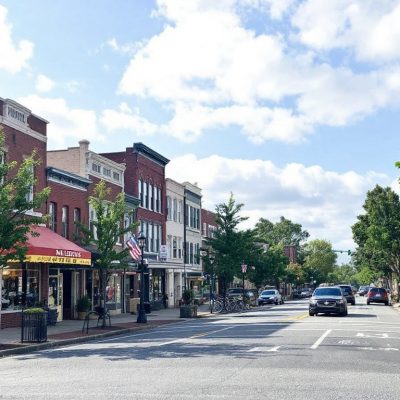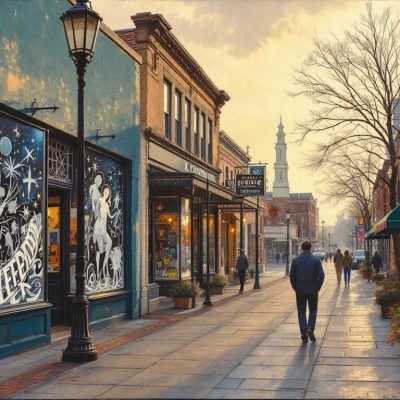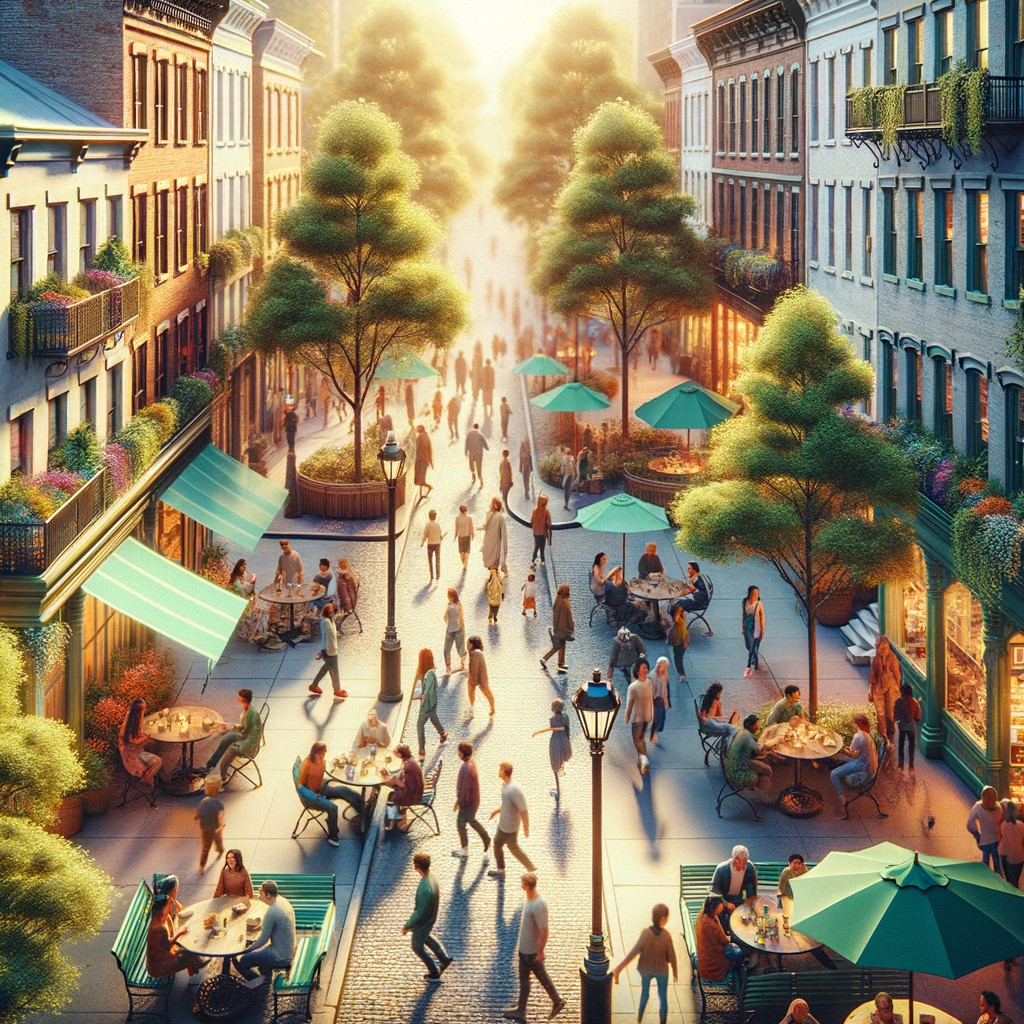Empty storefronts and tired, quiet streets—the story of struggling small downtowns feels familiar in towns everywhere. For decades, North America’s main streets have faced hard times. Big box stores, online shopping, and changing lifestyles have drained the foot traffic that once filled local shops and cafés.
The fight to keep downtown alive is a challenge for nearly every small city and town these days. But across the map, people still care. Local leaders, business owners, and residents work together, looking for ways to breathe new life into these once-busy centers. This story is about their struggles, setbacks, and real progress in turning things around.
A Flourishing Past: The Golden Age of Small Downtowns
Before empty windows and faded signs, small downtowns stood as proud symbols of thriving communities. These streets were the backbone of daily life, filled with people, purpose, and excitement from sunup to sundown. Pictures from the mid-1900s paint a lively scene: neighbors gathered on sidewalks, storekeepers swept doorsteps, and every storefront buzzed with business.
Main Streets as the Heart of Town
Every small downtown was something like a living room, only much bigger, open to all, and always changing. Main Street wasn’t just where you shopped. It was where you bumped into friends, shared a coffee, and caught up on the latest news. At noon, school kids grabbed lunch at the corner soda shop; after work, families went out for ice cream. The heartbeat of the town could almost be measured in the chatter, music, and laughter drifting through open windows.
It’s easy to forget how central these places were:
- Local merchants knew your name and offered a personal touch.
- Weekly markets filled the streets with produce and home goods.
- Theater marquees asked out for Friday night crowds and the latest blockbuster.
- Public events and parades brought everyone together, marking each holiday and hometown win.
Economic Engines and Community Identity
From the 1920s through the 1960s, small downtowns kept local economies strong. Every block offered goods and services—hardware, groceries, doctors, lawyers—often owned by neighbors who lived just down the street. The money spent downtown circled back into the local schools, parks, and libraries. This built not just wealth, but a sense of pride and commitment.
If you look back, main streets carried more than shoppers. They carried identity:
- Business owners passed stores down through families, rooting generations to the same place.
- Buildings showed off hometown style with signs, facades, and details you didn’t see anywhere else.
- Chambers of commerce promoted local pride in everything from floats at county parades to baseball teams with the town’s name across the chest.
Main Streets as Social Hubs
Downtown wasn’t just about work—fun and friendship grew there too. Whether you were sharing a soda at the lunch counter or walking with friends after dinner, main streets offered the glue that held towns together. Gatherings weren’t always planned. Sometimes they grew out of chance meetings outside the post office or a quick hello at the barber shop.
Let’s look at a few classic community gathering spots you might have found back then:
| Gathering Spot | What Happened There |
|---|---|
| Soda Fountain | Teenagers met after school, dates |
| Barber Shop | Local gossip and news shared |
| Movie Theater | Family outings, community events |
| Corner Store | Quick visits, neighborhood updates |
| Town Square | Parades, political speeches, fairs |
Downtowns became the shared memory book of each town. Holidays, milestones, and even the tough times were all written into the sidewalks and store windows.
Small Towns Shaping American Character
These bustling small downtowns created traditions and ties that shaped American identity. They were places where everyone counted. Loyalty to the local shop was a badge of honor. People learned to rely on each other, building trust in ways that shaped the character of entire generations.
When we look at photos of those glory years, we don’t just see old cars and vintage outfits. We see the stories, values, and friendships that once made small towns feel so alive. For many people, those memories are still what “home” means.
The Downturn: Factors Behind the Decline
Things didn’t change overnight for small downtowns, but the decline hit hard and fast once it started. Neighborhoods that were full of life and business found themselves facing empty stores, boarded-up windows, and slower days. Several outside forces combined to pull people away from main streets, leaving a once-loved part of town with an uphill battle just to hold on.
Rise of Suburbanization and Shopping Malls
Suburban growth transformed much of North America after World War II. Families moved just outside city limits, drawn by quieter streets, bigger yards, and the dream of homeownership. As people set down roots in the suburbs, business owners followed.
The arrival of shopping malls added fuel to the fire. These climate-controlled, all-in-one destinations promised easy parking and a long list of stores under one roof. Why drive downtown, circle for parking, and walk blocks in the rain when you could stroll a mall instead?
You could see it happen:
- Families built new homes and spent their days outside city centers.
- Chain retailers lined up in sprawling malls, offering more choices and big promotions.
- Downtown main streets lost major anchors—the clothing shop, grocery store, and pharmacy.
- Events and parades that once brought the whole town together began moving to suburban parks and venues.
This shift made small downtowns feel less essential. They once held everything a family needed. Now people picked up what they wanted without ever setting foot on Main Street.
The Impact of Big Box Stores and E-Commerce
Big box stores changed shopping habits in a big way. Huge new buildings promised low prices and variety that mom-and-pop shops couldn’t match. Retail giants like Walmart and Target didn’t just draw shoppers—they gutted the consumer base for the stores that kept downtowns humming.
Then, online shopping landed like a second storm. People pulled out their phones or laptops and ordered nearly anything they wanted, often with free shipping and easy returns. Local businesses struggled to keep up with the sheer speed and convenience.
Let’s look at what made the biggest differences:
- Lower prices and sales volume at warehouse stores.
- Longer hours—chains hardly closed, while downtown shops locked up early.
- One-stop shopping replaced the tradition of visiting specialty stores.
- Websites started offering 24/7 convenience, home delivery, and endless selection.
The result: fewer shoppers walked into local stores, and money that once circled within the town left for out-of-state corporations or vanished into the digital ether. Small downtowns, already hurting, saw their main income streams dry up.
Urban Planning and Transportation Shifts
A makeover of roads, parking lots, and city plans reshaped how people moved around. Some changes, meant to ease traffic, unintentionally boxed out small downtowns. Highways ran past small towns instead of through them. Parking lots appeared outside malls while downtown blocks turned into busy one-way streets with little parking.
On top of this, new zoning rules and building codes made it tough for old shops and historic spots to compete with new construction.
Here are a few of the biggest setbacks:
- Highway bypasses took drivers—and customers—away from the heart of town.
- Public transportation focused on routes to malls and suburbs, making downtown harder to reach.
- Crosswalks, sidewalks, and bike lanes got less attention, cutting walkability.
- Zoning changes sometimes favored bigger buildings, pushing out the smaller, quirky businesses that made main streets unique.
The shift left downtowns feeling cut off and inconvenient, no matter how charming or historic they remained. These towns found themselves fighting against both a physical and mental wall that kept shoppers and new owners away.
The signs of trouble weren’t always dramatic at first. But over years, the changes added up. Main streets faded, while new centers of gravity in suburban malls and big box clusters thrived at their expense.
Struggling to Survive: The Present State of Small Downtowns
Look at many small downtowns today and you’ll spot a tough reality. Blocks of empty storefronts sit where beloved shops or busy offices used to be. “For Rent” signs fade in dusty windows, and fewer people walk the sidewalks. The bright energy that once powered these spaces has dimmed as the local economy shifted and people moved on. What used to be the heart of town now feels uncertain, working hard just to stay afloat.
Economic Hardships and Business Closures
Downtown streets can feel like a row of hurdles for small businesses. Each year, stores close and rarely re-open, leaving behind darkened entrances. There’s a domino effect here. As a bakery or hardware store shuts its doors, less foot traffic moves by remaining shops. Owners quickly see lower sales, making rent and payroll even harder to cover. The pandemic made things worse, but these troubles started long before.
With less money coming in, business owners face hard choices. Some cut hours just to make it through another month. Others slash staff, struggle to keep inventory fresh, or give up after years of fighting to survive. This all hurts the local workforce, too. Teenagers lose their first jobs, families face more layoffs, and skilled workers might leave town for better pay elsewhere.
Several challenges keep piling up:
- Online retailers and big box chains capturing sales that once went to local shops.
- Steep operating costs eating into profits (think rent, utilities, insurance).
- Slow seasons lasting longer, while the busy days never really pick up.
- Empty buildings that spread more “bad news” vibes to shoppers and investors.
Here’s a quick look at how some places stack up:
| Year | Downtown Vacancy Rate | Average Foot Traffic Drop | Number of Annual Business Closures |
|---|---|---|---|
| 2000 | 8% | -20% | 2-3 per town |
| 2015 | 14% | -35% | 4-6 per town |
| 2024 | 22% | -53% | 7-10 per town |
A few banners on streetlights can’t hide the truth: Main streets need more than hope. They need real customers who want to spend their money downtown, not just online or at a superstore on the edge of town.
Consequences for Community Identity and Social Life
Downtown decline isn’t just about numbers. When these places lose their spark, it touches everyone. Main streets have long shaped the social heartbeat of small towns. Now, with fewer places to gather, those unique local flavors fade a little more each year.
What does that look like in daily life?
- Town festivals move to bigger parking lots or suburban parks.
- Old meeting spots, like cafés and diners, shut down or get replaced by chains.
- Shared traditions—like the holiday parade or summer street fair—draw fewer faces.
- Kids grow up without the memory of walking into a five-and-dime with their parents.
Losing downtown’s friendly welcome means more than “just another empty store.” It breaks chains of memory and belonging. People spend more time at home or leave for shopping and entertainment. That weakens the tight sense of community that used to define small towns.
When main streets shrink, so does civic pride. There are fewer casual run-ins with neighbors or local leaders. It’s harder to organize volunteer drives, share local news, or even celebrate wins as a town. Residents sometimes feel like their roots are loosening.
To sum up, a struggling downtown chips away at what makes each town special. Empty windows don’t just hurt business, they also dim the culture, memories, and togetherness that once made these streets come alive for everyone.
Revitalization Efforts: Stories of Hope and Innovation
Small towns across the country have rolled up their sleeves and gotten creative in order to revive their historic downtowns. While the struggles are real, the drive to bring life back to these main streets has inspired action and fresh thinking. Renewal comes in many forms: from neighbors joining forces to save a favorite building, to smart business deals that honor the past but steer toward the future. Let’s walk through some of the ways people are building new stories of hope on old main streets.
Grassroots Initiatives and Local Partnerships
People often say, “It takes a village”—and nowhere is this truer than in small town revivals. Locals have sparked hope by organizing, raising funds, and forming partnerships.
When a main street faces shuttered shops, it’s often the residents who step in first. They form groups, meet in coffee shops, and brainstorm ideas. Community development groups and nonprofit organizations help knit these efforts together, providing energy and resources. Local business owners, town leaders, and schools pitch in, turning big dreams into doable projects.
Here are some ways these partnerships bloom in real towns:
- Crowdfunding and Local Investing: Residents chip in for building repairs, marketing campaigns, or to help a new shop open its doors. These funds might come from bake sales, online platforms, or even “community bonds” where neighbors pool dollars for projects that benefit everyone.
- Volunteer Downtown Clean-Ups: Regular clean-up days bring together scouts, families, and shop owners. Flower beds get spruced up, murals get painted, and even small tasks like sweeping sidewalks show that people care.
- Buy Local Pledges: Towns run campaigns urging neighbors to “shop small.” Local newspapers and radio stations share success stories and highlight the businesses that have weathered hard times.
- Coalitions With Local Government and Chambers: City councils and chambers of commerce act as connectors, lining up grants, smoothing bureaucratic bumps, or encouraging pop-up shops and farmers markets.
Real wins come from keeping the focus small but mighty. For example, in Lindsborg, Kansas, townspeople turned empty lots into art parks, creating gathering spots that draw both locals and visitors. In Emporia, Virginia, a group of young entrepreneurs launched an annual “Downtown Takeover Day” to test new business ideas in vacant spaces. These efforts build pride and remind everyone that change starts at home.
Historic Preservation and Adaptive Reuse
Preserving downtown’s character means more than slapping a coat of paint on old bricks. In many places, townspeople and developers are rescuing historic gems from neglect, while adapting them for a fresh chapter.
Maintaining an area’s history gives people a sense of place. Instead of bulldozing the past, smart leaders save everything from feed stores to opera houses by finding new uses for tired buildings. It’s more than nostalgia. Restoring a historic building often costs less than a new build and keeps the spirit of “Main Street” alive.
Ways downtowns are reusing what’s old:
- Lofts and Apartments: Above old stores, empty spaces get a second life as affordable housing or unique apartments, drawing new residents who want to live closer to shops, culture, and nightlife.
- Boutiques, Breweries, and Restaurants: Former hardware stores or banks transform into restaurants, art galleries, or taprooms—injecting fresh business into familiar facades.
- Coworking and Makerspaces: Abandoned warehouses turn into shared workspaces or creative studios, attracting freelancers, artists, and start-ups that bring downtowns daily energy.
- Theaters and Event Spaces: Old cinemas and auditoriums host concerts, indie films, and town meetings, anchoring social life right in the core of town.
Successful examples include the Fox Theatre in Hutchinson, Kansas, where a grand art deco movie house now hosts touring bands and local events. In Sanford, Florida, once-derelict buildings are vibrant restaurants and microbreweries, saving the area’s architecture while making it a magnet for young entrepreneurs.
Adaptive reuse isn’t just about saving money or buildings. It brings together generations, boosts property values, and puts a bright spotlight on what makes each town unique.
Downtown as Destination: Festivals, Art, and Culture
Turning downtown into a destination gives people a reason to visit again and again. It doesn’t have to be fancy—sometimes a weekend farmers market or free concert is enough to get the buzz back.
Programmers and business owners know one key: give folks a reason to gather, and they’ll make memories. From block parties to art fairs, these events rekindle pride and grow local economies.
Popular types of downtown programming that spark crowds:
- Street Festivals and Seasonal Markets: Food trucks, holiday fairs, and arts & crafts shows bring life to empty blocks. Shoppers, families, and tourists fill streets that might otherwise sit quiet.
- Public Art and Murals: Bright murals and temporary installations create selfie spots, celebrate local history, and encourage exploration.
- Live Music and Open-Air Performances: Bands on street corners or mini-theater shows in pocket parks draw in people who might not usually make the trip downtown.
- Cultural Celebrations: Events that honor local history, immigrant heritage, or hometown legends bring everyone together and draw media attention.
- Foodie Events: Restaurant weeks or chili cook-offs invite locals to sample menus and cheer for their favorite chef or dish.
One great example is the annual “Alive After Five” event in Sanford, Florida, where local businesses, musicians, and artists fill the streets after work, driving sales and year-round excitement. In Athens, Ohio, their monthly “Final Fridays on the Square” brings families, students, and older residents into downtown for music, markets, and spontaneous fun.
Here’s what successful events have in common:
| Event Type | Outcome |
|---|---|
| Night Markets | Increased evening foot traffic |
| Mural Festivals | Instagram buzz, art walk tours |
| Heritage Celebrations | Visitors from neighboring towns, media coverage |
| Food Crawls | Restaurant boosts, social sharing |
By giving people something to look forward to, these programs do more than fill a calendar. They strengthen community ties, boost business, and remind everyone that small-town main streets still hold big potential.
Looking to the Future: Strategies for Long-Term Vitality
Small towns need more than band-aid fixes to keep their downtowns strong for the next generation. Turning hope into steady progress takes patience, teamwork, and a willingness to try new things without giving up what makes local places special. Here, we’ll explore practical steps that can help small downtowns build a future worth getting excited about.
Embracing Technology and Digital Presence
No matter how charming a main street looks, folks shop online and find information on their phones. Small businesses that ignore this reality will fall behind, but the good news is digital tools have never been more approachable.
A smart digital strategy means more than just having a website. Locals and travelers check Google, Instagram, and Facebook before ever stepping out the door. Businesses and downtown groups can:
- Set up or upgrade Google Business Profiles so people can find hours, reviews, and directions with a quick search.
- Create visually engaging and easy-to-update websites, featuring current specials, menus, or event calendars.
- Use Facebook and Instagram to share real-time updates about sales, live events, and community news.
- Link up with local influencers, artists, or photographers who already have an audience and want to promote what’s unique.
- Collect email addresses for monthly newsletters—often filled with coupons, stories, and sneak peeks at what’s coming up.
E-commerce opens another path. Even the smallest retailers can ship products, offer curbside pickup, or help customers shop outside of regular store hours. For service-based businesses like salons or gyms, simple online booking can make life easy for both owner and client.
Downtown associations can build shared resources too. Many places now have:
- Community websites or apps with maps, business listings, and event listings.
- Coordinated holiday markets with online previews of what’s for sale.
- Hashtags that encourage shoppers to post their favorite finds.
When main streets spread their energy online, they reach people sitting at home just a block away, or travelers planning a trip months out. This isn’t about tossing away tradition—it’s about meeting people where they are. Every click and comment is a new chance to draw someone into downtown for a real-world visit.
Building Stronger Connections Between Communities and Local Governments
Downtowns thrive when everyone rows in the same direction. Strong ties between local businesses, residents, and government help unlock resources and clear stubborn roadblocks. Sometimes all it takes is a single meeting to set big things in motion.
Local governments can set the stage for downtown revival in several ways:
- Offer grants, low-interest loans, or rent subsidies to make it less risky for a new shop or restaurant to open.
- Make codes and permits easy to understand so business owners don’t get buried in paperwork.
- Invest in simple but powerful improvements, like better street lighting, signage, planters, and benches.
- Keep up public spaces, making squares, sidewalks, and parks feel cared for and appealing.
Working together creates momentum:
- Business owners join city committees or economic boards, sharing honest feedback on what works or doesn’t.
- Towns host listening sessions, focus groups, or surveys to get input straight from the people who live and spend money downtown.
- Public-private partnerships tackle larger projects. For example, a local bank might help sponsor a block party or fund a mural, while building owners kick in by fixing facades or improving accessibility.
- Residents rally for initiatives like “shop local” taxes or funds that support both historic buildings and new ideas.
State and federal agencies have programs to help, too. Applying for grants takes time, but the payoff can be huge. Successful towns often have city staff or volunteers focused on finding these funds and helping businesses jump through the hoops.
Here’s a basic snapshot of what key roles each group might play:
| Who | What They Can Do |
|---|---|
| City Governments | Offer funding, update zoning, fix infrastructure |
| Businesses | Share needs, test new ideas, mentor new owners |
| Residents | Shop local, support events, spread the word |
| Nonprofits | Organize clean-ups, spark historic preservation |
| State/Federal | Provide grants, technical help, larger-scale programs |
When local leadership feels like a real partnership, it’s easier to dream big—and act fast—on projects that make a lasting difference. Together, small towns can choose steady progress over slow decline, building places where life feels full and future generations want to stay.
Conclusion
Small downtowns matter. They tell the story of a town’s past and shape how people connect today. Losing them isn’t just about closed shops, it’s about losing places where neighbors meet and local pride grows.
Communities do have a say in what happens next. Supporting a friend’s small business, showing up for an event, or volunteering for a cleanup can add up. Every step helps build the future these main streets deserve.
If your town’s heart is struggling, don’t look away—be part of its next chapter. Share your ideas, shop local when you can, and help others see what’s worth saving. Thank you for caring, and keep the conversation going below or in your own neighborhood.



